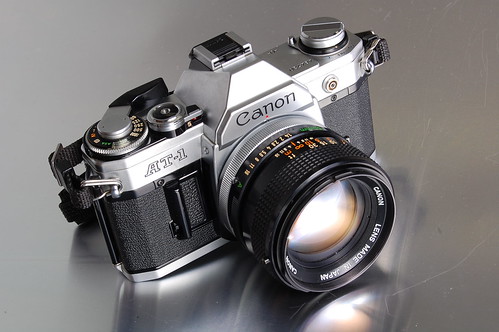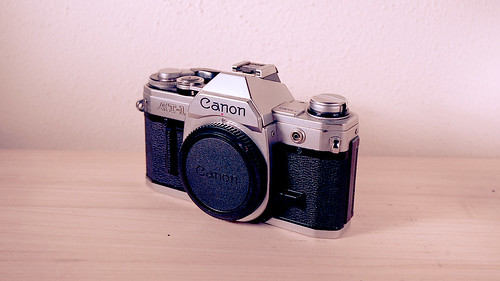Canon AT-1

|
| image by Raúl Sá Dantas (Image rights) |
Canon introduced the AT-1 in late 1976, about eight months after the immensely popular AE-1 made its debut. Both SLRs utilize the FD lens mount.
While outwardly the two models are near-twins, and share many accessories, the AT-1 was an export-only model offering cost-conscious buyers a cheaper alternative[1]. Where the AE-1 offers shutter-priority autoexposure, the AT-1 is a pure match-needle, manual-exposure camera. Its viewfinder display is a simplified throwback to earlier match-needle SLRs: an analog needle floats to reflect a TTL reading of the scene brightness; and the user adjusts either aperture or shutter speed until the EV "lolipop" aligns with the needle position. There is no indication of either the selected aperture or shutter speed in the viewfinder.
Despite these appearances, the AT-1 is not a full-blown retro mechanical SLR: it is based on the innovative cost-cutting electronics of the AE-1. The shutter is electronically timed and entirely dependent on battery power. A 10 second self-timer with blinking LED indicator is activated by rotating a tab alongside the shutter release to its forward position. (Rather illogically, returning the tab to its normal position does not cancel the self-timer; instead it fires the shutter immediately.)
While never selling in the same numbers as the AE-1 or AE-1P, today an AT-1 offers photographers access to numerous inexpensive, used FD-mount lenses, in a body free from extraneous bells and whistles.
Notes
- ↑ As stated in Canon's Camera Museum listing for the AT-1. Skimming advertised prices in the back pages of a December, 1977 Popular Photography magazine, the street price of an AT-1 appears to have been $40 or $50 USD cheaper.

|
| image by Sixtyfour (Image rights) |
Links
- AT-1 manual (PDF) at Mike Butkus' OrphanCameras.com
- AT-1 user reviews at CanonClassics.com
- Modern Classics Review
- The A Team an article about the SLR A models, AE-1, AT-1, A-1, AV-1 and AE-1 Program at Classic Cameras by RaúlM.
- AT-1 at www.collection-appareils.fr (in French)